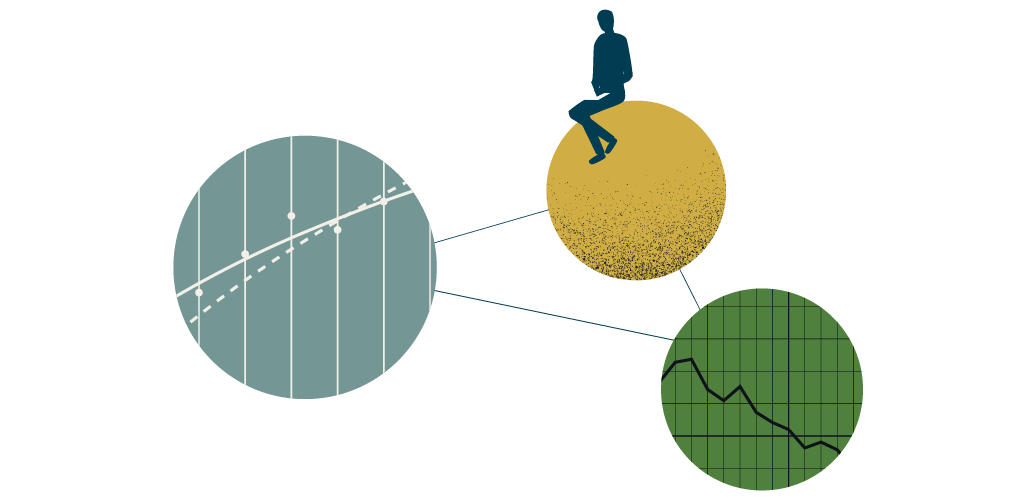Quarterly Market Outlook: Crossroads

By Liz Levy, CFA, Managing Director of Investment Research
In trying to think about how to describe our views on the economy right now, one image keeps coming back to me. As Dorothy sets off down the Yellow Brick Road, she comes to a crossroads, guarded by the Scarecrow, who first points her one way, then the other, and finally crosses his arms to point both ways. On the one hand, the stock market is at an all-time high as I write this in early October, with investors ignoring the political dysfunction and destruction and the weakening of important economic indicators. On the other hand, rumblings about overstretched valuations and AI bubbles continue to mount. So, which way?
Before we investigate our potential paths forward, let’s look at what just happened. The overall stock market, measured by the S&P 500, was up 7.8% in the third quarter and is up 13.7% for the first three quarters of the year. The AI spending spree continued, with tech stocks leading the way, up 13% in the S&P 500 for the quarter. Defensive sectors, such as consumer staples (down nearly 3% for the quarter), lagged the broader market, as is frequently the case in times of bullishness. The surge in stocks this quarter was partly fueled by the Federal Reserve rate cut in September, as the prospect of lower rates bolsters equities. The dollar, after falling in the first half of the year, stabilized in the third quarter.
Adapting to Shifting Economic Climates
Trying to discern what is coming next in financial markets always feels like more of an art than a science, but right now feels more fraught than other times. Part of that is political. It’s very challenging for me to fathom a sunny outlook while the government is shut down, economic data is unavailable, and various state National Guards are being activated to fight phantom violence. At the same time, the brutal reconciliation bill passed this summer does contain many business-friendly provisions, primarily tax breaks and deregulation. While AI is clearly a game-changing technology, the extent to which spending on AI technology is driving the market is reminiscent of the dot-com bubble and gives me pause.
At this point in the cycle, as the investment community hopes for further interest rate cuts, bad news in the labor market is cheered as good news for financial markets, highlighting the stark differences between Main Street and Wall Streets. At the stage of the market cycle where investors are expecting and waiting for the Federal Reserve Board to cut interest rates, “bad news” in the form of a weakening job market is often viewed positively, as it justifies the Fed cutting rates. Conversely, a stabilizing job market, which would otherwise be “good news,” makes it harder for the Fed to cut rates and puts downward pressure on stocks.
Businesses undoubtedly benefit from lower interest rates, particularly growth-oriented companies with economic models that are more sensitive to assumptions made about conditions several years in the future. At the same time, a euphemistically described weakening labor market means people losing jobs, having a harder time finding jobs, and working fewer hours for fewer dollars. These are impacts felt by real workers, real people, often separate from the investors that are benefiting from this strife. In the third quarter, evidence of these challenges showed up in earnings conference calls of consumer companies, who reported that customers are becoming more focused on value. For example, many fast-casual restaurants, frequently a step up from traditional fast food in nutrition and price, had very disappointing returns in the quarter as lower-tier consumers tightened their spending.
Similarly, when I think about the massive tax and budget bill passed this summer, it’s generally with dread about what it may mean for health care, or other topics I care about. But economists point out that the bill also contained investment-friendly provisions, such as those meant to spur businesses to increase domestic capital investment spending. Historically, they point out, data shows that this has led to increased jobs and economic activity in subsequent years. I’m having trouble wrapping my mind around what is essentially a supply-side, trickle-down theory of business tax cuts leading to economic growth.
Meanwhile, the chaotic rollout of ever-changing tariffs makes it nearly impossible for businesses to make long-term investment plans. At the same time, the tariffs being passed on to consumers, as well as the aforementioned weaker labor market, may hamper demand for the output of any increased production resulting from any investment that does happen as a result of this summer’s bill.
Which leads me to the growth of AI capital spending, investment that is happening right now on a grand scale. Throughout the third quarter and into the fourth, we continued to hear of massive planned investments in computing power and data centers, and AI-exposed stocks continued to dominate the market. The hope and promise—or hype in the minds of skeptics and detractors—of AI-driven efficiency and new capabilities for the companies that use AI, are beginning to be seen, but the eventual scope of benefits remains unknown. This dichotomy of enormous spending plans and uncertain benefits has resulted in fears of a bubble of over-investment in the technology and over-valuation of the stocks of companies providing it.
Managing the Risk-Return Spectrum
Putting it all together, at this moment, a reasonable investor could rationally justify both bullishness and bearishness on the economy. However, the stock market is very clearly in the bullish camp, with the S&P 500 near all-time highs and the cyclically adjusted price-earnings ratio, called the Shiller PE ratio, at levels only seen during the dot-com boom. As a result, we are continuing to manage portfolios in a somewhat barbell manner, with concentration at both ends of the risk spectrum. Overall, we are still positioned moderately defensively. However, we do have select exposure to companies that participate in the AI buildout, providing some exposure for the portfolio. Our intention is to build portfolios that will participate with the market should it keep rising but will also provide some shelter from the storm should it not. This is consistent with what we have been saying for the last few quarters—we are continuing to focus on building resilient portfolios crafted for the long term, comprised of high-quality companies that meet our social and environmental standards.
Another thing that is consistent is our connection to and rootedness in our values. Our commitment to advancing equity, justice, and sustainability remains baked into all the investment decisions we make. Our purpose always is to maximize the positive impact of our clients’ financial assets while meeting their financial goals, through proxy voting, shareholder advocacy, and impact investing. In these chaotic and scary times, I continue to be proud of the work we are doing on your behalf.
Watch Clean Yield in Conversation: Market Outlook October 2025
More News & Insights
Get to Know Clean Yield Impact Investing Associate Monica Charletta
Monica Charletta brings a background in impact-first regenerative food systems investing and ESG strategy consulting to the team.
Read More >Fraud Prevention Strategies: What It Is and How to Protect Yourself
Clean Yield hosted a webinar, “Fraud Prevention Strategies: What It Is and How to Protect Yourself.” This summary includes resources to help you prevent fraud.
Read More >Supporting Local News and Democracy
Clean Yield is proud to announce it will provide an annual donation to support the American Journalism Project for the next three years to further AJP’s investments in local journalism to support preserving our democracy, increasing civic engagement, and depolarizing communities.
Read More >

